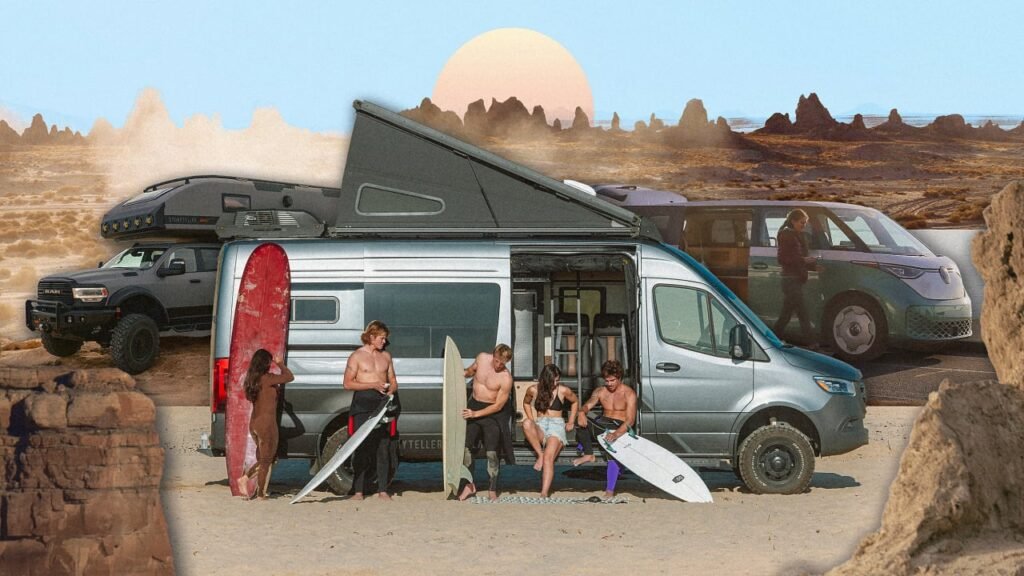
While not everyone bought a camper van during the COVID-19 pandemic, we all probably know someone who did. As people with money suddenly found themselves with time on their hands and no particular place to be, sales of compact but full-featured Class B camper vans soared, increasing 91.5% from 2020 to 2021, according to the RV Industry Association (RVIA). Van life became a hashtag, a lifestyle, and an aspiration. While sales have settled back down to pre-pandemic levels, the market for high-end vehicles remains strong, with manufacturers tempting new and returning buyers with an array of new models that push the limits of performance, luxury, and price.
And then there are all the new rugged details. Not content to stick to the pavement, the latest cohort of van owners wants to get off-road, too—or at least look like they do. You may have spotted an increasing number of Mercedes-Benz Sprinter vans bedecked with all manner of racks, ladders, spare tires, and fuel cans, traction boards, and outdoor gear. These are the “overlanders.”
The overland category includes a variety of vehicle types—from 4x4s accessorized with trendy rooftop tents, to burly Class C camper trucks (see EarthRoamer.com), to all-terrain “adventure vans” that combine the comforts of much larger campers with the off-road performance of an expedition vehicle. The promise is appealing: get to wild places that others can’t, and sleep comfortably (and maybe stream some Netflix) when you get there. With massive fuel reserves, freshwater tanks, and arrays of solar panels and lithium-ion batteries, today’s top-of-the-line adventure rigs are designed to support days or weeks of self-sufficient off-grid exploration.
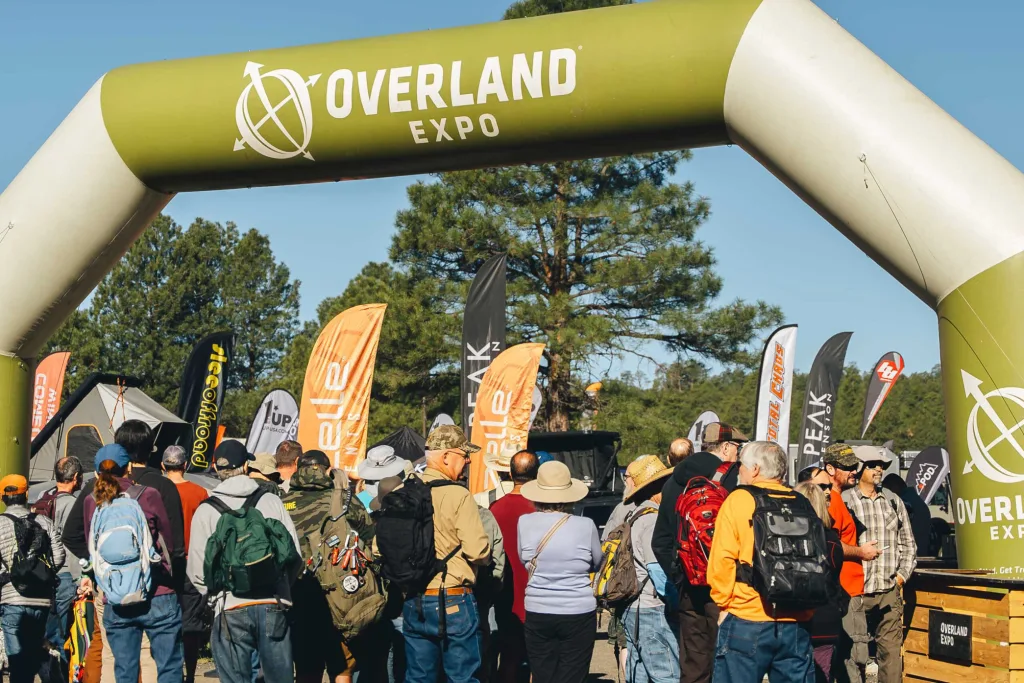
This blend of comfort and adventure is exactly the draw for overlanders, who are largely an affluent, middle-aged bunch. According to the RV Industry Association’s 2025 RV Owner Demographic Profile, 13% of current RV owners cite the ability to camp off-grid, or “boondocking,” as a primary motivator in their vehicle purchase. The biggest U.S. overlanding event, Overland Expo—where owners come to camp out and would-be owners come to check out vehicle “builds,” has grown from one event with 800 attendees in 2009 to five regional events in 2025. (The inaugural Southern California event this March had 19,000 attendees and 303 exhibitors. Subaru is the first-time lead corporate sponsor.) The 2024 event series attracted more than 80,000 attendees, up 35% from 2021. More than 12 million Americans are expected to overland in 2025, up from 8 million in 2024, according to the Overland Expo’s new 2025 Overland Industry Report.
Here’s a look at that vanguard of compact RV innovation as we roll into the summer of 2025.

An overlander from Alabama
The brand that might best embody the luxury overland zeitgeist of 2025 is Birmingham, Alabama-based Storyteller Overland, which launched in 2018.
Now in its second year of production, the hulking 2025 GXV Epic is the sort of thing you would choose to caravan across the Australian Outback while being pursued by zombies. The 30-foot-long turbo diesel 4×4 has an 1,800-mile range and comes equipped with a 200-gallon freshwater tank, an 18 kWh battery capacity (enough to power a small home for a whole day), and expansive solar panels for recharging. It can be yours for about $800,000. It takes 2,500 man hours to complete each Epic build—since the vehicle’s launch in May 2024, the company has built roughly one per month.
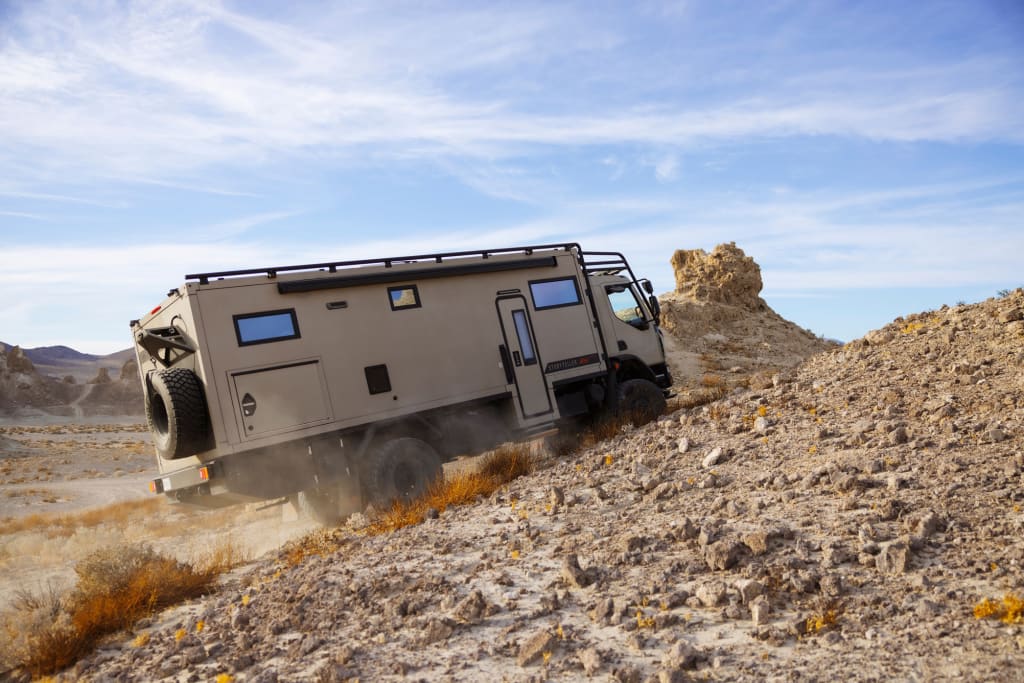
Storyteller’s GXV Hilt is another “adventure truck” that came to market last year—a deluxe camper “capsule” bolted to a Ram 5500 that’s been upfitted with a “liquid spring” smart suspension system, a proprietary “no torsion” subframe system that allows the capsule to move independently from the chassis, and a heavy-duty spray-on coating to protect it from scratches. With a 52-gallon diesel-fuel capacity, 16.8 kW lithium-ion battery storage, solar panels, and 120-gallon freshwater hold, the Hilt is built for long hauls, but not for roughing it. It’s got a full bath and kitchen, and two queen beds. Storyteller can build the $499,000 trucks at a rate of about one per week.
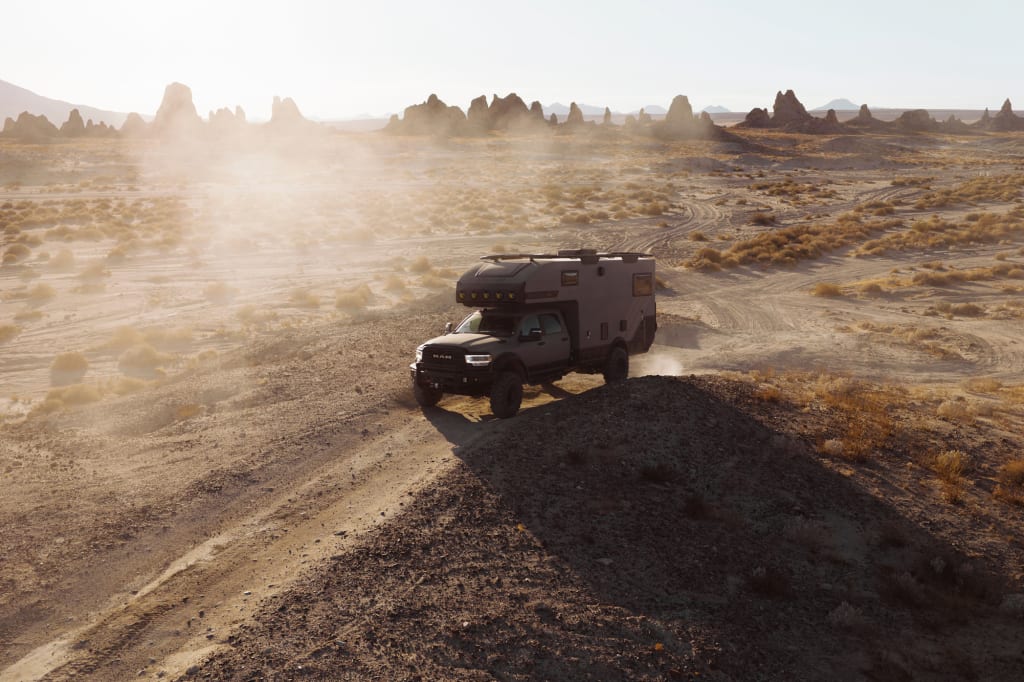
But Storyteller’s bestsellers are its line of Mode camper vans. Built on the tall, boxy Sprinter chassis, the 2025 models cost between $185,000 and $250,000, depending on features. The premium Beast Mode XO boasts all-wheel drive, nubby off-road tires, and a heavy-duty suspension system—plus an expandable 90 W solar panel, onboard batteries, and a 21-gallon freshwater tank to live off-grid for days or weeks. The muscular exterior sports a front grille “brush guard,” a safari-style roof rack, side-mount ladder, rear cargo box, and high-intensity LED lighting. The cabin, insulated with sheep’s wool, has air conditioning and diesel-fueled heating, a galley kitchen with refrigerator, sink, microwave, and induction cooktop, and a full bath with toilet and hot shower.
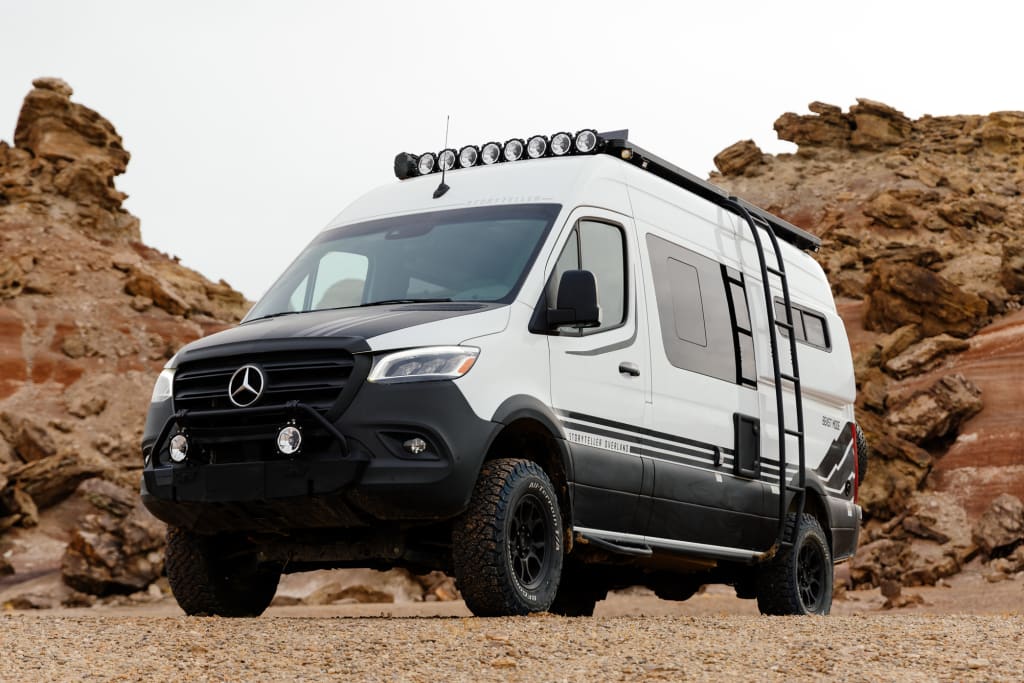
Employing about 215 people at its Birmingham headquarters and at a production facility in Missouri, Storyteller has built more than 2,500 of its vans to date. Its sales are strongest in the West—where vast publicly owned lands provide ample off-grid camping opportunities—but are growing through the South, Midwest, and Northeast, as well. The company took a “significant” investment from private equity group L Catterton last year to accelerate product development, invest in manufacturing, and grow its dealer network, it said.
Storyteller doesn’t have a monopoly on adventure campers. Its success seems to have inspired old-school RV players such as Winnebago and Thor Industries to up their overland game. Adding to its existing line of Class B campers, last year Thor launched the Palladium and Talavera, built on the Ford Transit Trail chassis with all-wheel drive and off-road capabilities, starting at $110,000. This year, Winnebago launched its Revel Sport, a lighter, lower-priced version ($210,570 base price) of its popular Sprinter-based Revel 44E adventure van (base price, $245,463). If none of the off-the-shelf options fit the bill, conversion specialists including Campo, Ridgeline Van, Cascade Van, Papago, Tommy Camper Vans, and Sequoia + Salt offer custom builds featuring designer finishes, artisanal woodwork, advanced electronics, and more—for a van-included price of about $150,000 to $300,000.
Changing demographics, endless upgrades
Storyteller says that its customers include “preppers,” early retirees, and younger families, with the typical buyers being men over 50. That’s a decade or so younger than the consumer base for giant Class A RVs, and reflects a broader shift in RV ownership. According to the latest RVIA survey—which covers owners of all types of campers and trailers—the median age of RV owners has declined from 53 in 2021 to 49 in 2025. (To get a sense of “overlanding” spectrum, check out van-focused We’re the Russos, started by traveling couple Joe and Kait Russo in 2018, and truck-focused TrailRecon, created by U.S. Navy veteran Brad Kowitz.)
The new overlanders often come into van ownership via outdoor recreation, and use their vehicles as home base for other active pursuits. According to the RVIA, the leading hobbies while RVing are fishing (47%) and hiking (44%). The most popular recreational equipment hauled along on RV trips are bikes and kayaks, but the list for a well-prepared overlander could also include skis, surfboards, and more. Not surprisingly, accessories for carrying gear—bike carriers, surfboard hooks, “Alpine boxes,” and safari-style roof racks—are popular add-ons. But that’s just the start.
Even buyers who start with fully loaded adventure van soon find themselves wanting more.
The 2025 Overland Industry Report found that nearly 80% of overlanders plan to make upgrades in the next year—with a focus on durability, lighting, and storage. The aftermarket accessories industry has been surging: the number of eBay Motors “overlanding” listings for things like rooftop tents, swingout tire carriers, and winch kits increased was up more than 3,500% in 2023 compared to 2019.
Online sellers that focus on the upscale adventure van set—including Owl Vans, Main Line Overland, and Flatline Van–sell everything from racks, ladders, bumpers, and awnings to lighting, lift kits, skid plates, and wheels. DIYers can even build out a full camper van interior with modular components—beds, tables, cabinets, and kitchen units—from companies such as Portland, Oregon-based Adventure Wagons, or flat-pack style conversion kits made of natural plywood from Simi, California-based VanLab or Timber Van Kits, in Boulder, Colorado.
For the current wave of adventure campers, being off-grid doesn’t mean being offline. In the 2025 RVIA survey of van owners, 54% of those who work remotely do work from their RV. Companies such as Brooklyn Campervans have seen increasing demand for vans as remote offices, complete with Starlink antennas, solar panels, advanced energy storage systems (see Battleborn, Renogy, and Volta), and USB ports for devices. Starlink’s ROAM program explicitly targets RVers and van lifers —and its marketing leans in to the overlanding zeitgeist (if you can ignore the Cybertruck). To be sure, taking a Zoom meeting from the middle of a desert or a remote beach site is a particular kind of flex.
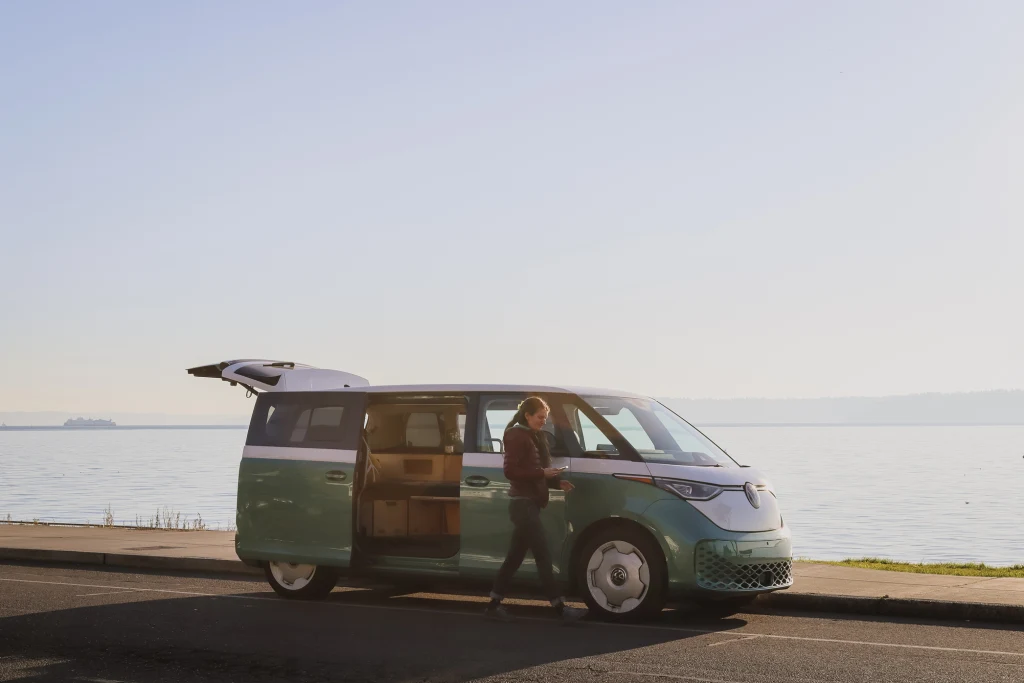
The future of van life is electric, and increasingly female
Fully loaded camper vans can weigh as much as 5 tons, and they’re gas guzzlers. In optimal conditions, a diesel Sprinter-based model might get 25 mpg or so. In addition to being hard to parallel park, they’re not ideal for running errands around town.
While Trammel at Storyteller says that interest and sales in its vehicles are still “good,” the broader category has continued cooling even after the pandemic spell wore off. According to the RV Industry Association, sales of so-called Class B camper vans last year were 30% below 2023, and were slightly down year over in March 2025.
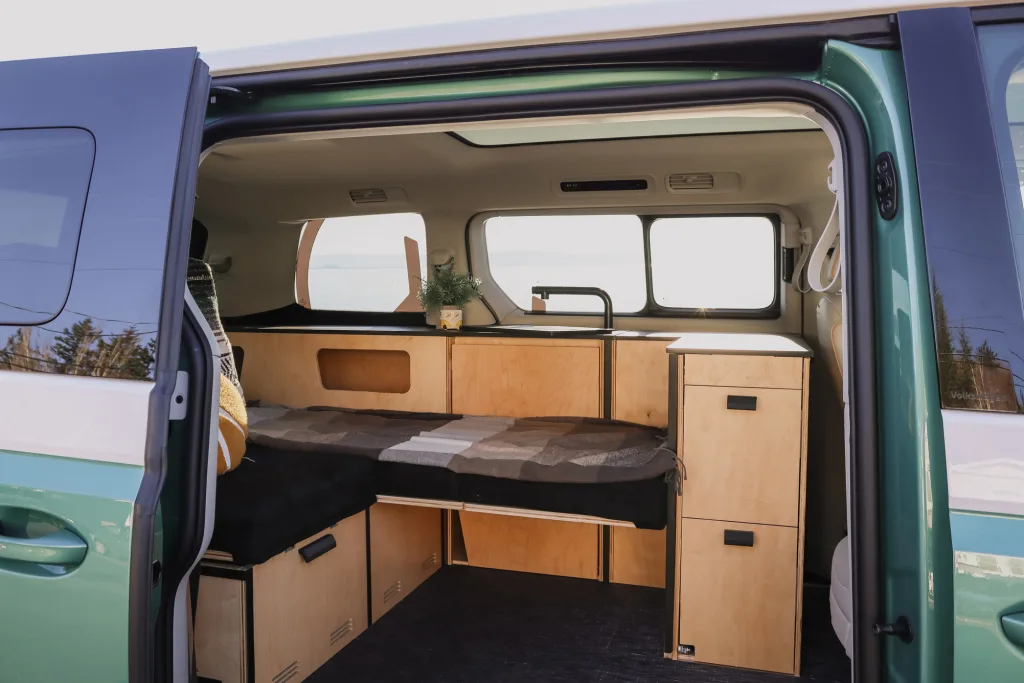
“There are people who want to spend $200,000 on a really high-quality camper van, and [companies] satisfying that need,” says Harley Sitner, a former senior product manager at Microsoft and now owner and manager of Peace Vans in Seattle. “Is it starting to wane a little bit? Yes, absolutely.” His shop focuses on a different segment of the market, specializing in dual-purpose small vans suited to daily driving and the kind of modest adventuring that most people are actually up to. “You don’t want a dedicated camper van that sits idle in your driveway a hundred nights a year and your neighbors laugh at you,” says Sitner.
Until recently, his shop—which employs 27 people, including contractors—specialized in custom conversions of the Mercedes Metris van, a smaller-platform vehicle than the Sprinter, which was discontinued at the end of 2023. “We did over a thousand of those, and we could have done another thousand if they kept making them,” says Sitner. Starting this year, they began doing custom buildouts of Volkswagen’s new EV van, the ID Buzz (as well as converting older VW camper vans to EVs).
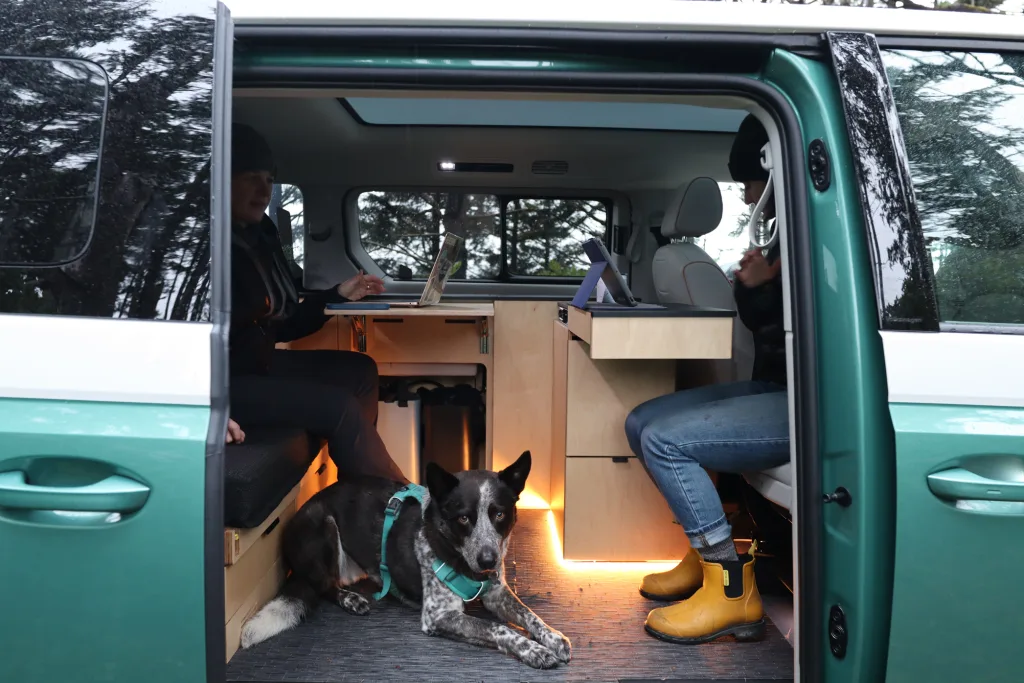
Long-term, all vehicles are moving to electric, although it’s not yet practical for real overlanding. The Mercedes eSprinter, for example, introduced in 2023, has a top range of just over 200 miles, a lower payload capacity than the diesel version, and no all-wheel drive option. But, the current ID Buzz, with a range of about 230 miles, is just right for Sitner’s customers, who want to go on two- to three-night camping trips, or have a comfortable place to chill between surfing sets.
“We’re not going to compete with Storyteller or Winnebago or all these custom builders,” says Sitner. “We’re going to focus on the small niche and get most of it. It’s not a $100 million market, but it’s a pretty big market.”
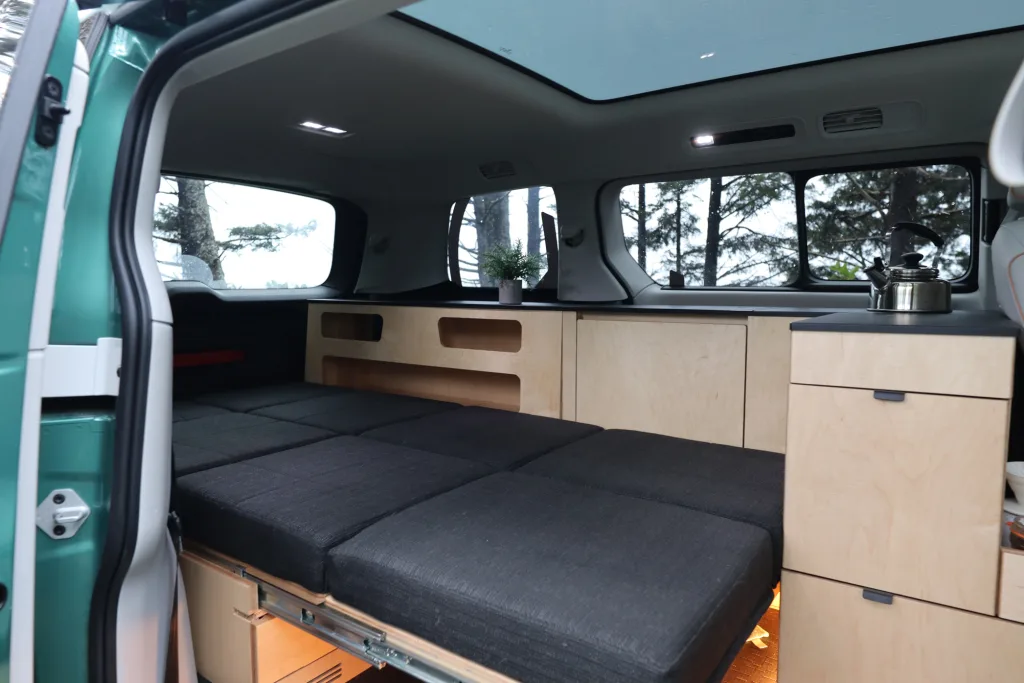
For a full camper conversion, Peace Vans pulls out both rows of rear seats, replacing them with a foldout bed, and adding a kitchen unit with a sink, stove, and refrigerator. A small van, Sitner says, “is like a boat. Every inch counts. You’ve got to be really, really thoughtful about it.” Peace Vans can also add a rear kitchen box, leaving more space inside for people and gear. And this fall, it will offer a new pop-top tent option—a beloved feature of vintage VW camper vans.
“The nostalgia factor is not to be discounted,” says Sitner. “Almost every one of our customers had a VW van in the day. There’s this innate organic demand.” The customer demographic skews more female than the Big Van market; Sitner estimates that some 40% of his customers are single women over age 55. “The ID Buzz is very yin. You’re not going to go stomp nature. You’re going to go hang out with nature.”
Sitner expects to work on 400 to 500 vehicles this year—at prices, vehicle included, ranging from about $80,000 to $120,000. The impact of Trump tariffs are a wildcard. He thinks that Volkswagen would absorb a percentage of increased costs, but he says that because of tariffs, “we’re not going to scale as quickly, and it’s a bummer. The good news for us is our customers are not price sensitive.”


